A Resistance View of the Long War
A review of Yahya Sinwar's novel, The Thorn and the Carnation
At the end of the 2021 war, a Hamas leader gave a speech among the carnage of Gaza. He told the press and public that he would walk home, that the Israelis knew where he was, and if they wanted to make him a martyr that would be their chance. Instead, he ended up going home and sitting on an intact piece of upholstery amid the rubble of his house.
Today that leader - until 2011 a prisoner of Israel’s, now the head of Hamas’s political bureau - is in the tunnels of Gaza, directing the war effort against Israel’s genocidal army.
Two decades ago, Yahya Sinwar wrote a novel. It should be required reading for friends and enemies of Palestinians alike, but it was banned from Amazon and circulates instead on the back channels of the web. The Thorn and the Carnation was written inside Israeli prison, copied by hand and smuggled out: Sinwar’s words escaped Israel’s dungeons years before the author got out in a prisoner exchange. The novel is a document of Palestinian life under occupation from the 1960s to the early 2000s and reveals the perspectives and priorities of one of the main Resistance leaders of our time.
Colonizers are always obsessed with the leaders among the oppressed, and Sinwar obsesses the Israelis like no one else at the moment.
In the preface of the book, Sinwar says that all the events in the book are real but have only been transformed into fiction to “to fulfill the form and requirements of a novelistic work.” As a graduate of the Arabic Literature program of the (now destroyed, along with every other university building in Gaza) Islamic University of Gaza, Sinwar would know. Imprisoned not long after his student years (he was born in 1962 and imprisoned in 1988, sentenced to life), Sinwar wrote a book where most action takes place in the three sites central to an occupied people obsessed with education: the camps, the campuses, and the prisons. There are no corporate boardrooms, glitzy hotels, yachts, or even weapons laboratories. Readers of the Thorn and the Carnation witness the construction of the Resistance in seemingly impossible conditions, humble locations, under the ever-watchful eye of the occupier.
Morally and practically prescriptive, the novel is not written from an ironic distance, but from the point of view of a youth growing up and learning of the world. Corrupted characters and villains - the occupation and collaborators - play their roles across from upright Resistance characters and heroes. The protagonists’ family hold fully-drawn out debates between communist (Popular Front for the Liberation of Palestine), Islamist (Hamas), and nationalist (Fatah) members. All positions are reasonably portrayed, but the Hamsawis get the last word.
A review of the book by Haneen Odetallah in Mondoweiss draws the philosophy of Sinwar out of the text, showing how the protagonist’s cousin (more like a brother), Ibrahim, represents the values of a Resistance fighter: Self-sacrifice, asceticism, and security awareness.
Certain military concepts can also be drawn out by reading Thorn and Carnation. In it, a frank and undramatic narration of Israeli atrocities coexist alongside an ever-evolving assessment of Resistance possibilities.
Long before the current genocide, Israel’s actions could have formed the basis of a horror novel, but the Thorn and the Carnation is a novel of action. While occupation persists, resistance never stops, and never will. Its forms change, but through all the harms inflicted upon the people, it grows. Even if Sinwar himself were killed in the current war, the Resistance would go on.
The book describes a Gaza Strip in the 1960s constantly under patrol by the Israeli army, in which guerrilla fighters would move in silence and come out of hiding for an ambush. “The resistance men would dominate the camp at night, making it impossible for the occupation patrols to enter its alleys. They stayed on the main streets, and with the break of dawn, the resistance men would disappear.”
The actions and the deaths of martyrs are reported in a straightforward style:
“A significant event that year was the martyrdom of our neighbor Abu Yousuf. He, along with two other young men, had set out to execute a mission against the occupation patrols. Their strategy involved one of the fighters throwing a grenade at the patrol that regularly passed through the main street at a specific time, then retreating in a way that made him visible to the soldiers. Abu Yousuf and another fighter, armed with Carl Gustav rifles and grenades, lay in wait for the reinforcements that would pursue the first attacker. Unfortunately, they were ambushed unexpectedly from behind, and both Abu Yousuf and his comrade Ibrahim were martyred on the spot.”
As a child, the protagonist, Ahmed, witnesses the public execution of a collaborator, followed by an Israeli mass arrest operation; imprisonment and torture of random men from the community. Characters are introduced to show how Resistance is organized: recruiting, building networks, acquiring weapons. Resistance members, like everyone else, get swept up in the Israeli dragnet, and the novel reveals how they conduct the struggle even while being interrogated:
“As is usual in resistance work, one of the cells encountered an operational failure, leading to the arrest of its members. Under severe interrogation, some began confessing, leading to more arrests, eventually reaching Abu Ali. He was captured and subjected to intense interrogation in the dungeons of Hebron prison. Abu Ali showed great resilience and refused to confess even the simplest things that some of the young men, deceived during the interrogation, had admitted.” His partner had confessed, but the uncle didn’t: “Abdul Fattah was taken to Hebron prison and subjected to severe interrogation and torture, as they questioned him about his relationship with Abu Ali and tried to convince him that Abu Ali had confessed everything. However, Abdul Fattah continued to deny the allegations. Consequently, he was sentenced to six months of administrative detention without any charges, while Abu Ali received a five-year sentence based on the confessions obtained from some of the young men who weren't resilient enough to withstand the interrogation ordeal.”
The ones who don’t confess to anything end up free sooner, while confessions lead to worse sentences for everyone. The message is clear.
The chapters covering the 1970s dive deeply into prison life - the counts, loudspeakers, food, bathroom shifts, beatings, being made to sit on a blanket non stop, one five minute shower per week, one bar of soap for dozens of people… then the military court / kangaroo court. A young reader of the novel would know what to expect when the Israelis nabbed him and sent him to prison. This part of the novel conveys the centrality of the prisoners’ struggle to Palestine, and the importance of liberating the prisoners to the Resistance. After the prisoners adopt the hunger strike, the Israelis make conditions a bit better and the prison becomes a Resistance school in its own right:
“In the following period, cultural, religious, and educational gatherings in prison became very common. In one room, there was a session discussing Palestinian history; in another, a political session about the latest developments; in a third, a session about the principles, slogans, and objectives of the Fatah movement; and in a fourth, a session on socialist thought and Marxist philosophy. The prison transformed into an advanced school where learners taught others, and those inexperienced in debate and political thought were trained.”
As the chronology moves into the 1980s, the protagonist’s older cousin, Ibrahim, the model Resistance fighter, comes into his own. He studies and prepares, builds a family life and a business while getting an education and working underground in the Resistance.
Before the First Intifada (1987-1989) the Resistance is at a low point and Israeli intelligence looks unbeatable:
“The occupation's intelligence had begun to infiltrate the camp gradually, systematically, and deliberately. Anyone opposing or objecting would find the intelligence officer responsible for the area sending dozens of summonses to young men and men to his office. They would sit in the waiting room for hours, then be called in one by one, to be beaten, threatened, warned, bargained with, consoled, and efforts made to recruit them.”
How did the Israelis recruit? Through blackmail, bribery, corruption, and, from the Islamic perspective, through immorality as well:
“It became clear that through its agents, the occupation's intelligence started promoting the trade and use of hashish, drugs, and alcohol. They considered this a means to destroy the nation and kill any spirit of resistance, while the agents saw it as a quick way to make money with their appearance protected. The agents began to promote corruption and immorality by spreading obscene pictures, magazines, and sexual videotapes among boys and girls.”
A reader of the book would be forewarned against these Israeli methods:
“It was clear that the occupation's intelligence, using its agents, systematically practiced spreading organized corruption to destroy the people and end any hope of a future for liberation or resistance. Every day, their methods in this field evolved, to the extent that one of the well-known agents' offices would announce registration for a tourist trip to areas inside the Green Line. During these trips, with dozens of naive young men, several prostitutes known for their collaboration with the occupation's intelligence were taken along.”
But despite all the infiltration and Israeli intelligence success, resistance persists. The Intifada indeed begins. In the Thorn and the Carnation, there is no separation between the armed struggle, the intelligence war, and the popular struggles on campuses or in the streets. The Israelis do not differentiate between these and neither does the Resistance. In the latter half of the novel, there is a switch to third-person narration as details of how organization proceeds and what methods are employed by both occupation and Resistance, e.g.:
“...the territories were completely devoid of weapons; the occupation had methodically worked over nearly two and a half decades of its occupation of Gaza and the West Bank to empty the regions of weapons and ammunition and to seal all avenues through which they might be brought, imposing severe penalties on anyone involved in this trade. People didn’t even know how to use weapons if they found them. Therefore, activists resorted to using bladed weapons like knives, daggers, machetes, and swords, in addition to batons, and it was very rare to see an old Carlo Gustav rifle or a pistol.“
On organizing the Intifada:
“They are planning and organizing the escalation of the Intifada and confrontations in the city and surrounding towns and villages. They agree to work on two fronts: first, to activate the events and incidents wing of the Intifada, and second, to start establishing armed groups and cells and to gather weapons for them.
“One of the attendees departs to meet three young men to announce the formation of the core of the armed effort. They are instructed to start searching for weapons, prepare hideouts and shelters, and nominate candidates ready to engage in this field. Meanwhile, dozens of activists move in various directions to mobilize individuals and supporters to distribute pamphlets, write slogans on walls, and set up barricades on roads to hinder the movement of occupation forces and settlers, drawing them into suitable locations for stone-throwing, thus facilitating the youths' camouflage, withdrawal, and maneuvering.”
When the Intifada winds down and Fatah signs the Oslo Accords with Israel, the debate between Hamas and Fatah on the peace process takes place in the protagonists’ family home, between Ahmed’s brother, Mahmoud, who is with Fatah, and his cousin Ibrahim, with Hamas. When Mahmoud says that the Palestinians needed an agreement to establish the beginnings of a state in the West Bank and Gaza, Ibrahim replies:
"It’s clear that continuing resistance and military activities, which cause human losses to the occupation, along with a popular uprising that inflicts political and media damage, will force them to withdraw from the Gaza Strip and the West Bank. Then we can establish a state on any piece of land from which the enemy withdraws... If they leave by an agreement, it means that we Palestinians must adhere to certain obligations, the least of which is recognizing their right to our remaining land. However, if they leave without an agreement under the pressure of resistance, it means that we have committed to nothing and the door remains open for us to continue immediately or later... when we find it appropriate."
As the Intifada dissolves into the Oslo Accords, Ibrahim he gives a speech in prison, to his fellow prisoners, about how the Resistance would start over and over again, as many times as necessary:
"...All sacrifices of the first Intifada have been wasted, and now, with the politicians and negotiators, we’ve reached a deadlock. What’s stopping us from starting anew?"
"Hundreds, if not thousands, of martyrs will fall, and tens of thousands will be wounded. You'll find someone to propose going to a new Oslo, or whatever you want to call it. After every round of our people’s struggle and sacrifice, the politicians come to reap the fruits; because they rush to harvest the fruit before its time, they are punished by being deprived of it. Neither does the fruit stay on the tree to ripen, nor is it useful when harvested because it's not yet ripe. This was the solution with our people’s first Intifada, and now we must start again until someone imagines that the fruit has ripened and its time has come, only to destroy everything our people have sacrificed for."
In Ibrahim’s view, the pressure of Resistance alone is what led to the partial withdrawal of Israel from the occupied territories, and the easing of that pressure that led to the reoccupation.
The novel goes through the 1990s in a whirlwind of Israeli repression and Resistance operations. In the end, Israel is at a crossroads, unable to decide how to proceed, as Resistance continues to grow.
In Mahmoud’s (Fatah) view, continuing Resistance after the agreement was endangering the Palestinians, who had no way of defeating Israel. Ibrahim addresses this defeatism directly, as Mahmoud says the Israelis could easily crush the Palestinians.
"Then why haven't they crushed us? The components of the equation are not merely about pure military strength, Mahmoud. Israel knows it faces an Arab and Islamic nation behind us, fragmented yes, but if it used excessive force against us, the balances of the universe would turn. Israel is unable to crush us because it is governed by many equations, and breaking any one of them means it could be crushed as well."
Ibrahim’s journey ends in martyrdom, from a helicopter-launched missile striking his car. That, too, is symbolic of the way, in the world view of the Thorn and Carnation, a model Resistance fighter’s life should end while occupation persists.
In the end, the great characters in the Thorn and the Carnation exhibit persistence - through pain, grief, prison, and torture. They don’t reveal themselves to the enemy. They are not fooled by the enemy’s deception and are not intimidated by the enemy’s violence. They study and learn and prepare, even as they fight. They will fight on regardless of setbacks and even through genocide.
The narrative of the novel ends in 2004. Two decades later, Israel is one year into a genocide against the Palestinians, with the full support of all Western countries, led by the US. The leader of the genocidal campaign is Benjamin Netanyahu. The leader of the principal Palestinian Resistance organization is Yahya Sinwar.
At the moment, Israel, governed as Ibrahim says “by many equations”, is trying to break them, all to try to crush the Resistance. Increasingly it seems that by the end of this war, the Resistance will either have to “start anew”, or Israel will, as Ibrahim calculated, be crushed by the equations it has tried to ignore.





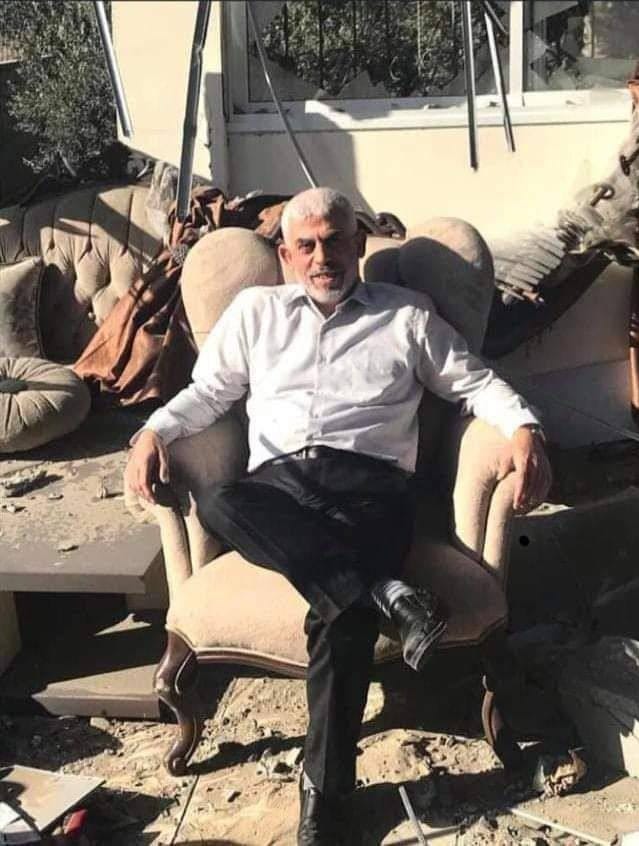

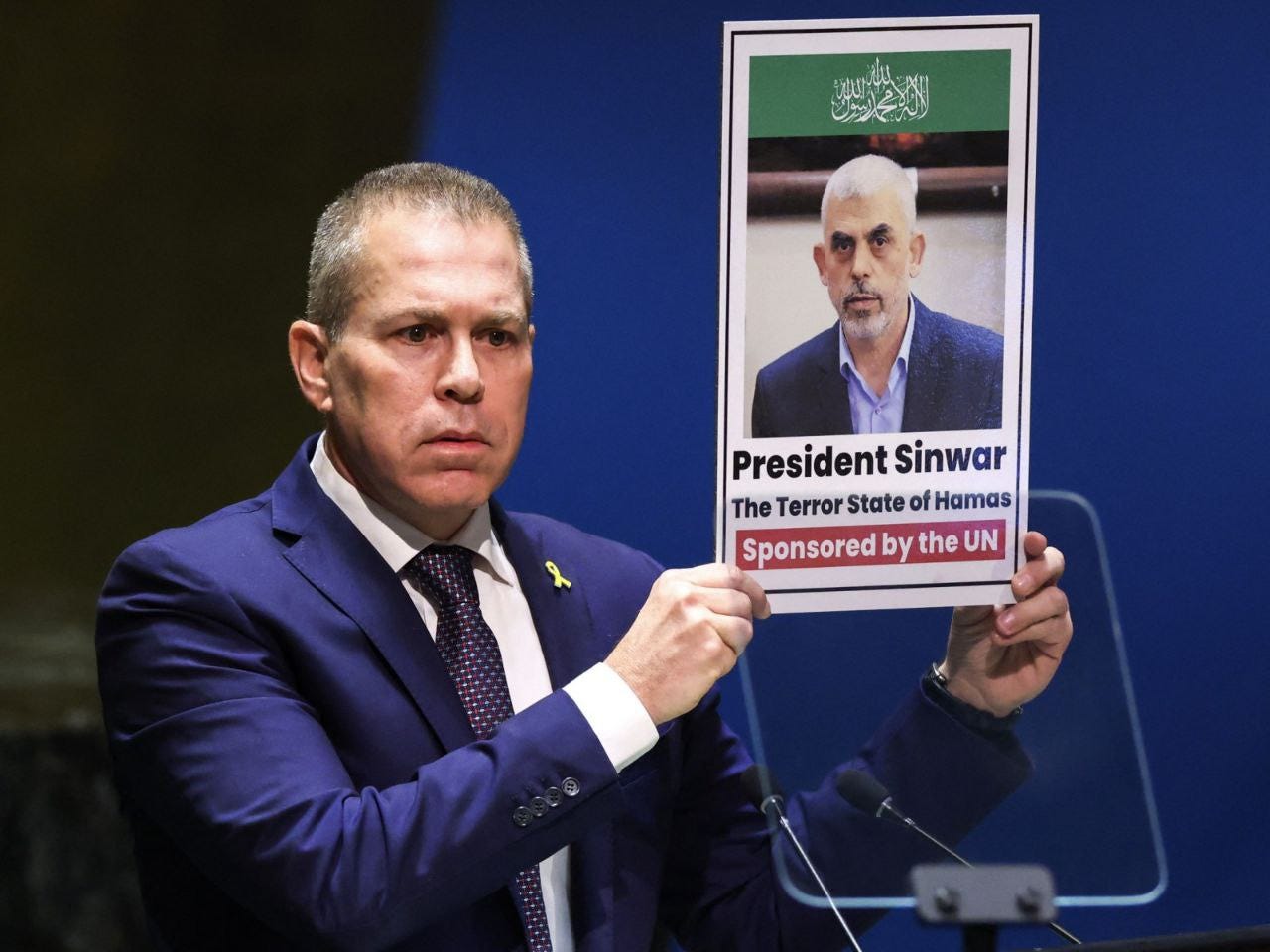
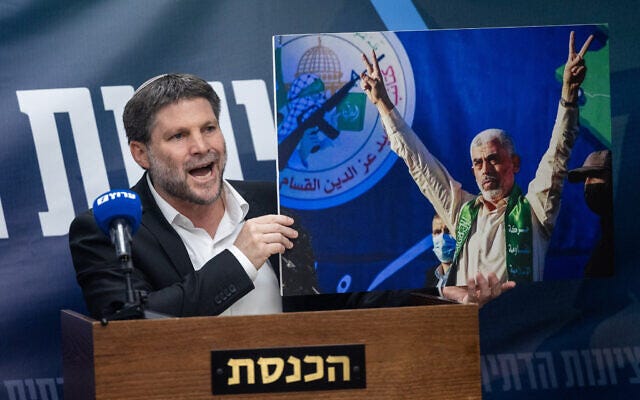


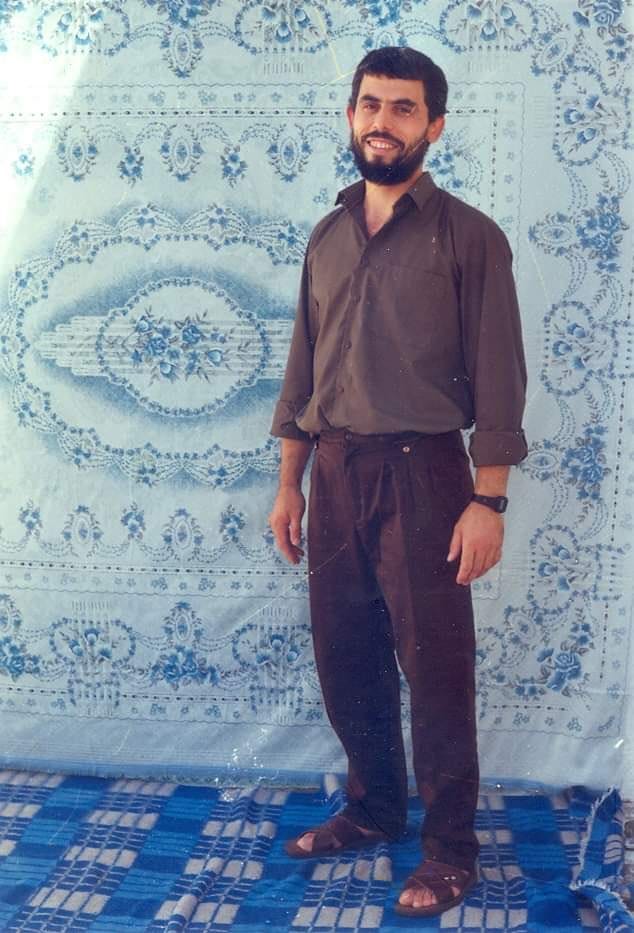
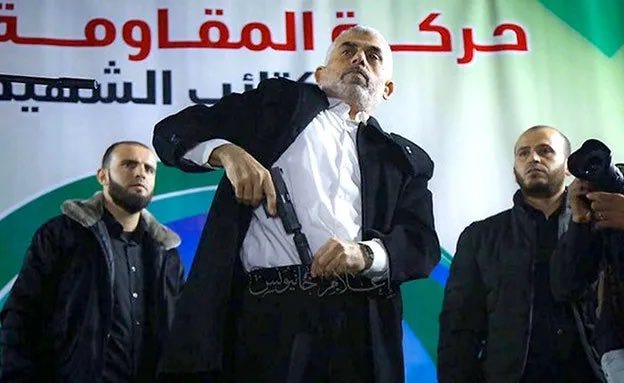
Available in digital format at Anna's Archive:
https://annas-archive.org/md5/bc02ec75bcdcfcaeb7b9068bc5bbb2c2
also in Arabic for those so endowed
This is a fantastic piece, helping humanize the resistance and understanding the decisions that lead them to today. I havent read the novel, but just from the overview here, it reminds me of The Battle of Algiers, which, like TatC, both tragic and inspiring. Like always, thanks for writing!